Key takeaways:
- Embracing negative feedback can lead to significant improvements and growth in game development.
- Collecting feedback through surveys, forums, and in-game options fosters community engagement and drives meaningful changes.
- Analyzing patterns and trends in feedback helps identify precise areas for enhancement, leading to a better player experience.
- Implementing player-suggested changes can transform user experience and deepen connections with the gaming community.
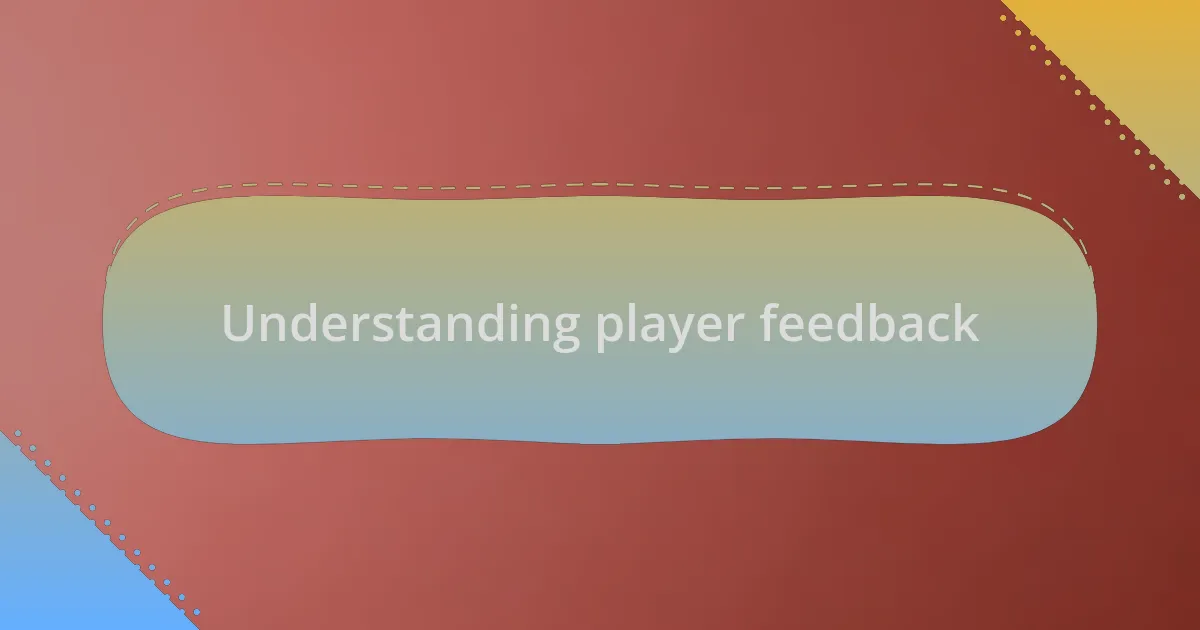
Understanding player feedback
Understanding player feedback is vital for any game developer, as it serves as a direct line to the player’s experience. I remember a moment when I incorporated feedback from players about a game mechanic that frustrated them. That tweak not only improved the gameplay significantly, but it also deepened my connection with the players; their voices were heard, and that made all the difference.
When I look back on my development journey, one thing stands out: the emotional weight of negative feedback. Initially, it stung. However, I learned to see it as a goldmine for growth. Have you ever faced criticism? It can be daunting, but that discomfort often leads to the most significant improvements in your work. Instead of shying away, I found it beneficial to embrace these comments, dissecting them for insights.
Moreover, understanding player feedback means recognizing the patterns behind their thoughts and feelings. I often hesitated to make changes based on a few isolated comments, but eventually, I understood the importance of trends. If multiple players express similar sentiments, it’s a clear indicator that something needs addressing. Don’t you think it’s fascinating how a collective voice can steer the direction of development? This collaborative dialogue not only enhances the game but also fosters a community that feels invested in its evolution.
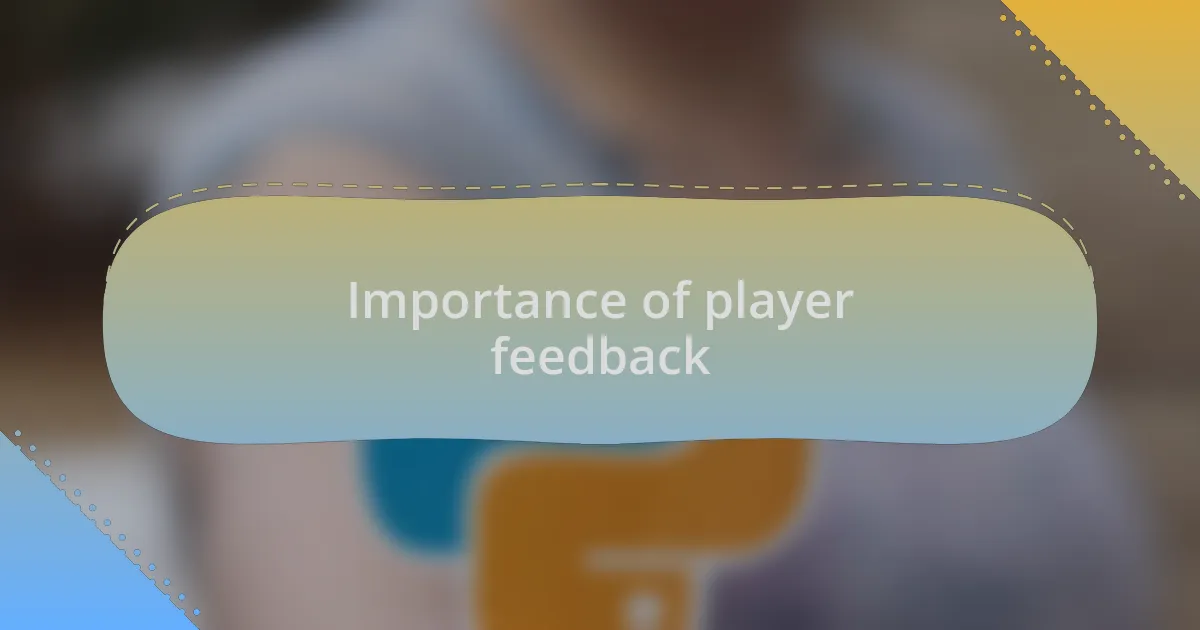
Importance of player feedback
Player feedback is an essential tool for enhancement, shaping not just gameplay but the entire player experience. I recall an instance when players repeatedly mentioned their frustration with a tutorial level being too challenging. By focusing on that feedback, I managed to redesign the level, making it more accessible without compromising its fun. The relief and gratitude expressed by players reaffirmed the value of listening to their needs.
Understanding player feedback also fosters a unique relationship between developers and the gaming community. There was a time when I unleashed a patch that was rushed due to my excitement, only to receive backlash for bugs. Instead of being defensive, I engaged with the players on forums, addressing their concerns directly. That interaction transformed my perspective; I realized that my players were not just consumers, but partners in the creation process.
Ultimately, the specificity of feedback allows developers to identify precise areas needing attention. For example, when players suggested minor adjustments to character animations, I initially brushed it off. However, realizing that these seemingly small tweaks could impact immersion significantly reshaped my approach to development. Isn’t it intriguing how even the smallest detail can resonate deeply with your audience? That’s the power of feedback—it connects us to the very heart of our creations.
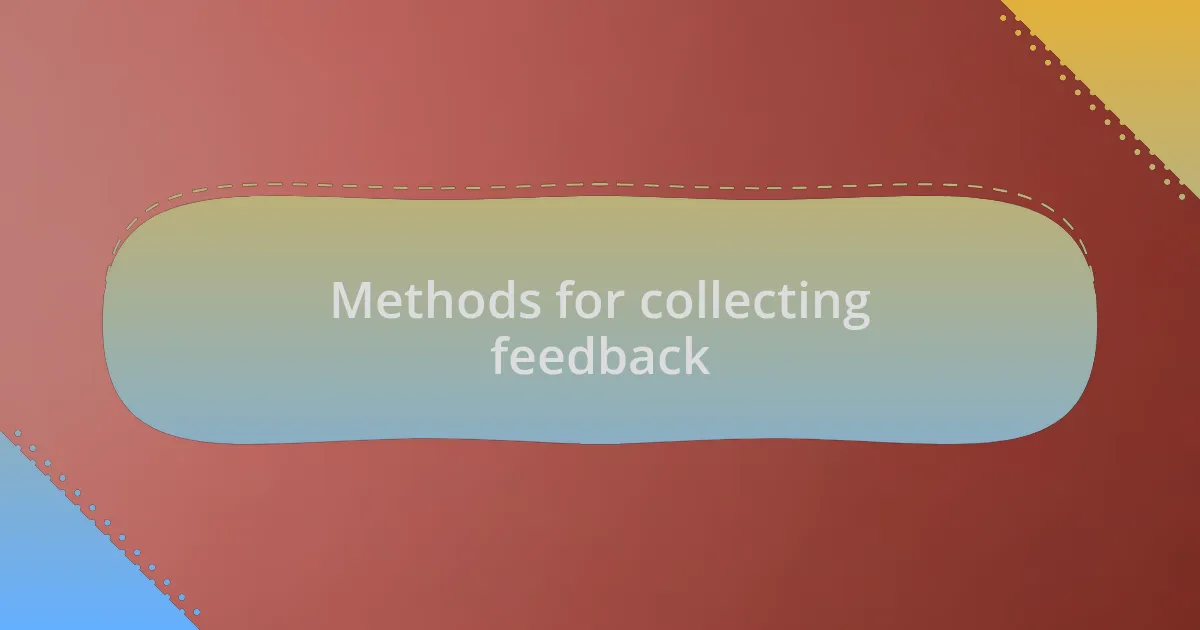
Methods for collecting feedback
Collecting feedback can take many forms, and I’ve found that direct communication often yields the most insightful responses. One method I often utilize is creating simple surveys that allow players to share their thoughts on specific features. In one case, I received a surge of comments praising a new character design, which encouraged me to not only keep that style but to explore similar aesthetics in future releases. Isn’t it fascinating how directly asking players for their opinions can open the door to unexpected ideas?
Another valuable technique I’ve adopted involves engaging players in forums or social media platforms. These environments create a casual atmosphere where players feel comfortable sharing their insights. I remember a time when a player posted a detailed critique about the pacing of a level. Instead of brushing it aside, I took their feedback to heart, ultimately leading to an enhanced gameplay experience. Don’t you think that discussions in these spaces can bring out diverse perspectives that make our games even better?
Lastly, I’ve experimented with implementing in-game feedback options, like rating systems or comment boxes. This allows players to express their thoughts immediately while the experience is fresh. During one gaming session, I noticed a spike in players providing feedback about a particular mechanic that seemed confusing to them, prompting me to revise my tutorials accordingly. Have you ever considered how timely feedback can lead to swift improvements, directly benefiting the player experience?

Tools for gathering player insights
One of the tools I find incredibly useful for gathering player insights is analytics software. These tools help track player behavior, revealing which levels are engaging and where players struggle. I once analyzed gameplay data and discovered a specific level where many players dropped off. By addressing the design of that level, I managed to improve player retention significantly. Have you ever reflected on how data-driven decisions can create more enjoyable experiences?
Another effective method I’ve employed is player interviews. While they can be time-consuming, they provide rich qualitative data that surveys sometimes miss. I remember sitting down with a player who had a unique take on game mechanics; their perspective illuminated aspects of my game I hadn’t even considered. Isn’t it interesting how personal conversations can uncover gems of insight that statistics alone might overlook?
Lastly, integrating feedback tools within beta testing phases has proven invaluable. By inviting players to share their thoughts during this stage, I’m able to make immediate adjustments based on their experiences. I recall one beta test where players highlighted an imbalance in character abilities. By implementing their suggestions, I was able to enhance the competitive aspect of the game. Have you thought about how beta feedback can shape the final product in ways you hadn’t anticipated?
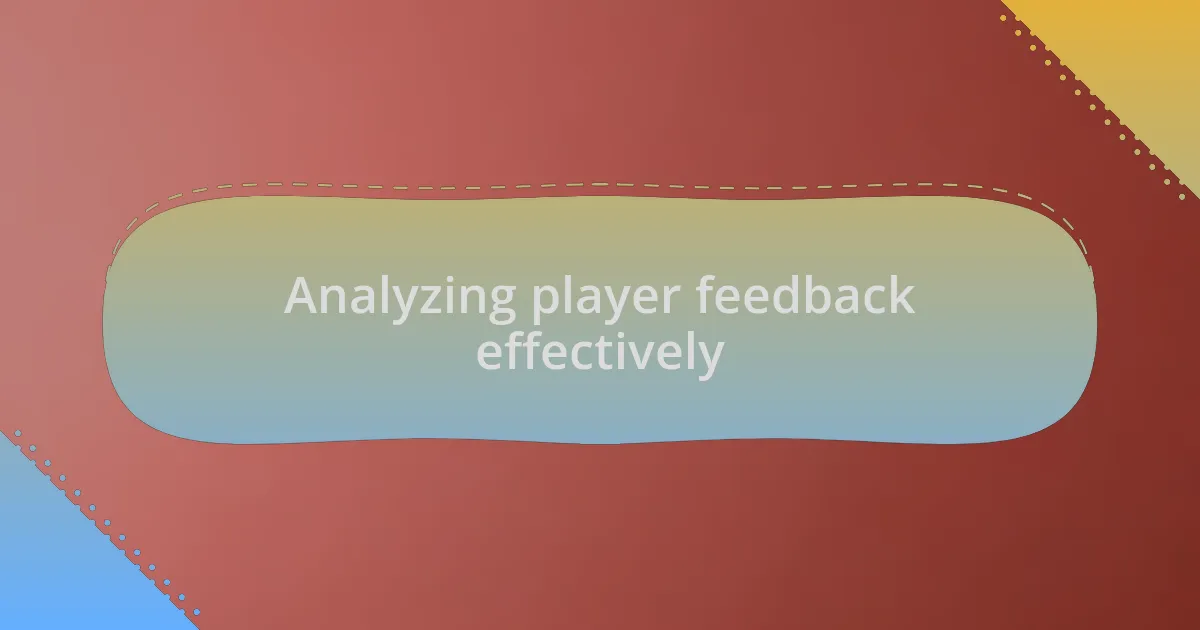
Analyzing player feedback effectively
When I dive into player feedback, I focus on identifying patterns and trends. For instance, during one game development cycle, I noticed consistent complaints about in-game tutorials being too complex. Analyzing these repeated concerns led me to simplify the onboarding process, which was a game-changer. Have you ever experienced how refining a small detail can transform the overall game experience?
In my experience, categorizing feedback into themes can streamline the analysis process. I once grouped suggestions into gameplay mechanics, graphics, and difficulty levels, which made it clear where improvements were necessary. It’s fascinating how organizing feedback can not only clarify issues but also guide creative solutions. Don’t you find that having a structured approach can alleviate the stress of sifting through overwhelming comments?
Lastly, I recommend cross-referencing player feedback with your game’s analytics data. This combination provides richer insights for making informed adjustments. For example, I once paired player comments about a level being too hard with analytics showing high dropout rates at that specific point. By correlating these observations, I could pinpoint precise changes needed. Doesn’t it feel reassuring to have both qualitative and quantitative data working together to enhance your game?
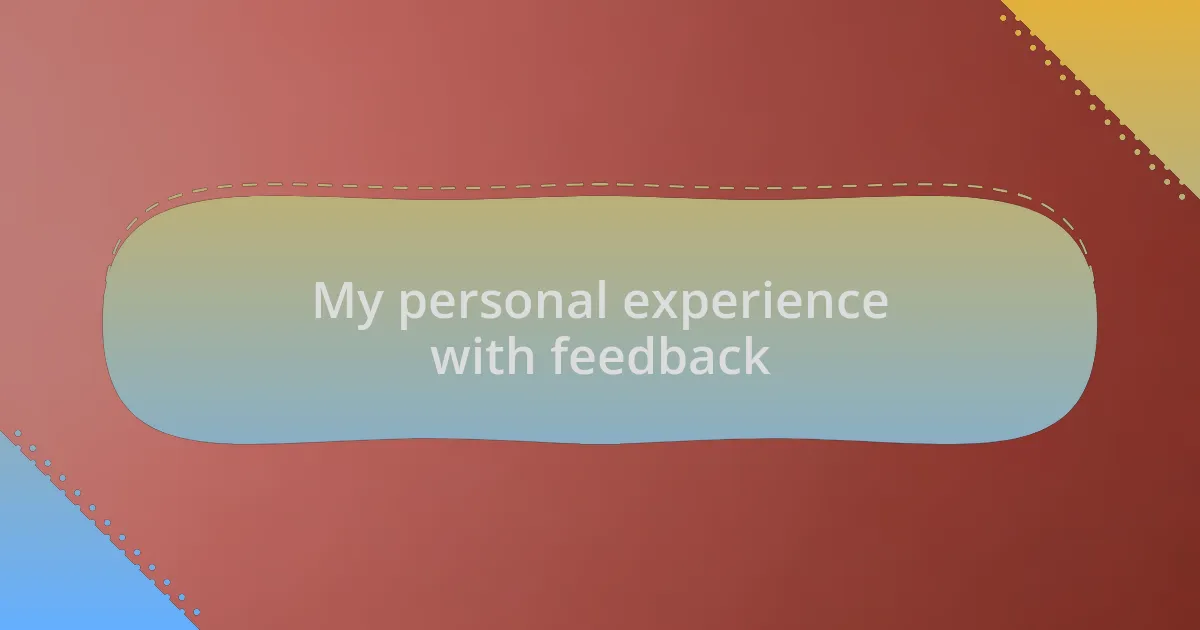
My personal experience with feedback
When it comes to receiving feedback, I remember a particularly impactful moment during a beta test of my game. Players were vocal about the pacing of the storyline, and initially, I was defensive. But as I read their comments, I realized they genuinely wanted to engage with the narrative; my ego was in the way. Have you ever been surprised by how feedback can challenge your preconceived notions?
Another instance that stands out for me occurred after I implemented a new feature based on player suggestions. Initially, I was hesitant, fearing that it might disrupt the core experience. However, the overwhelming positive reactions once the feature rolled out showed me the value of truly listening. It’s amazing how stepping back and embracing feedback can lead to breakthroughs that I never anticipated, isn’t it?
I often reflect on how my approach to feedback has evolved over time. In the past, I used to shy away from criticism, feeling it was a personal attack. Now, I actively seek out feedback and see it as a toolbox filled with opportunities for growth. Has your perspective on feedback shifted over the years? Embracing this mindset change has been a game-changer for me, fueling both my projects and personal development.
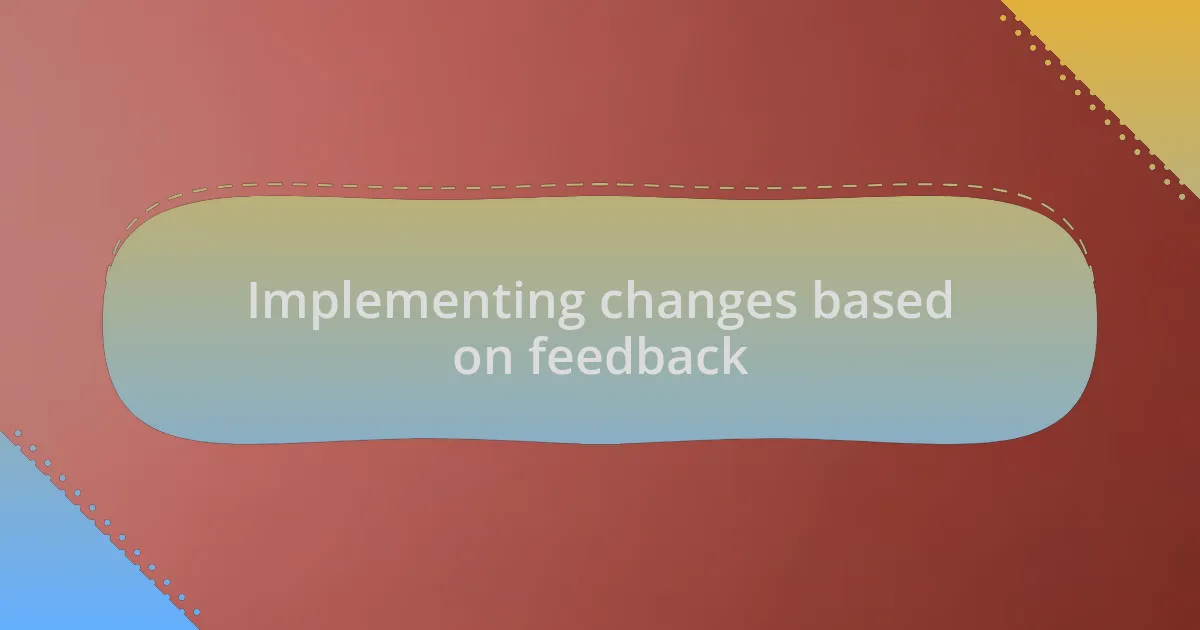
Implementing changes based on feedback
When I finally decided to implement changes based on player feedback, I focused on prioritizing the most common suggestions. One notable example was when users requested more tutorials on specific programming concepts. After I added those resources, the increase in engagement was palpable. Have you ever felt that rush of excitement when your efforts align with what your audience craves?
Looking back, I used to be overwhelmed by how much feedback I received. At times, it felt like swimming in a sea of opinions with no lifeguard in sight. Over time, I learned to sift through the noise, identifying trends that truly mattered. This targeted approach not only streamlined my workflow but also helped me address real player needs more efficiently. It’s fascinating how recognizing patterns can make the feedback process feel less daunting, don’t you think?
One of the most rewarding changes I made came after integrating a suggestion about user interface improvements. Players voiced their struggles navigating my site, and that feedback struck a chord with me. Making those adjustments transformed the user experience and, honestly, hearing players praise the new layout brought me immense joy. Have you ever felt that deep sense of satisfaction when your work resonates with your audience?